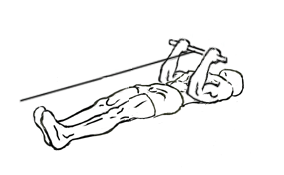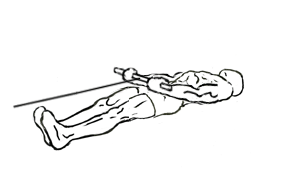Last Updated on September 25, 2014
Building strong, defined biceps is a common goal for many fitness enthusiasts. While traditional exercises like dumbbell curls and barbell curls are popular, the Lying Bicep Cable Curl offers a unique approach to bicep training by isolating the muscle and providing constant tension throughout the movement. This exercise eliminates the use of momentum, helping you focus solely on working the biceps. In this detailed guide, we’ll explore everything you need to know about performing the lying bicep cable curl effectively and safely.
What is the Lying Bicep Cable Curl?
The Lying Bicep Cable Curl is an isolation exercise that targets the biceps by using a cable machine. Unlike traditional standing or seated curls, lying down allows you to remove other muscle groups from the equation, ensuring that your biceps are doing all the work. This exercise is excellent for developing both strength and muscle definition in the biceps, and it’s suitable for all fitness levels.
Muscles Worked
- Primary Muscles: Biceps brachii (long head and short head)
- Secondary Muscles: Forearms (brachioradialis and brachialis) for grip stability
By isolating the biceps, this exercise ensures that these muscles receive maximum engagement, promoting both muscle growth and strength gains.
Benefits of the Lying Bicep Cable Curl
- Full Range of Motion: Cables provide consistent tension throughout the entire range of motion, ensuring the muscle is engaged from start to finish.
- Eliminates Momentum: Lying down removes the opportunity to use body momentum, common in standing curls, allowing for better muscle isolation.
- Reduces Lower Back Strain: Since you’re lying down, there’s no stress on your lower back, making it ideal for those with back issues.
- Versatile and Adjustable: The exercise can be performed with different attachments, grip variations, and weights to match your fitness level and goals.
- Improves Bicep Peak: By focusing on bicep isolation, you can work on developing the peak of your bicep, enhancing its overall shape and size.
How to Perform the Lying Bicep Cable Curl
Equipment Needed:
- Cable machine with adjustable pulley
- Short bar attachment
Step-by-Step Instructions:
- Set Up:
- Attach a short bar to the cable pulley, setting the pulley at the lowest point of the cable station.
- Lie down on a mat or directly on the floor with your head positioned closest to the pulley and your feet touching the weight stack for stability.
- Grasp the Bar:
- Reach up and grasp the bar with an underhand grip (palms facing up) about shoulder-width apart.
- Your arms should be fully extended with your elbows resting comfortably at your sides.
- The Curl:
- With your upper arms fixed, curl the bar up towards your chest in a controlled motion. Focus on contracting your biceps as you lift, keeping your elbows close to your sides.
- Aim to create a slight arc as you bring the bar towards your chest, ensuring your forearms do the work.
- Peak Contraction:
- Pause at the top of the movement when the bar is close to your chest. Squeeze your biceps hard and hold the contraction for a second or two.
- Lowering the Weight:
- Slowly lower the bar back to the starting position, maintaining control to keep tension on the biceps throughout the descent.
- Avoid locking out your elbows completely to maintain tension in the biceps.
- Repeat:
- Perform 3-4 sets of 10-12 reps, ensuring that each repetition is controlled and precise. Rest for about 60-90 seconds between sets.
Form Tips for Maximum Gains
- Keep Elbows Tight: Your elbows should remain locked at your sides throughout the movement. Avoid allowing them to move forward or backward, as this can reduce the effectiveness of the exercise.
- Avoid Using Momentum: The movement should be slow and controlled. Focus on isolating the biceps by preventing your upper body from lifting off the floor.
- Engage Your Core: Keep your core muscles tight to maintain stability and prevent your lower back from arching off the ground.
Common Mistakes to Avoid
Even though the lying bicep cable curl is an effective exercise, performing it incorrectly can diminish its benefits and increase the risk of injury. Here are some common mistakes to watch for:
- Swinging the Weight:
- Using momentum to lift the weight takes tension off the biceps and can lead to injury. Focus on slow, controlled movements for maximum muscle activation.
- Incorrect Grip Width:
- Gripping the bar too wide or too narrow can affect your form. Aim for a shoulder-width grip to maximize bicep engagement and reduce strain on the wrists.
- Arching the Back:
- Your back should remain flat on the floor throughout the exercise. If you find yourself arching your back, reduce the weight and focus on engaging your core.
- Not Using a Full Range of Motion:
- To fully activate the biceps, make sure you complete each rep with a full extension and a strong contraction at the top of the movement.
Variations of the Lying Bicep Cable Curl
To keep your workouts diverse and continue challenging your biceps, consider incorporating these variations:
- Single-Arm Lying Cable Curl:
- Perform the exercise one arm at a time. This variation can help address any strength imbalances between your arms while increasing focus on each bicep individually.
- Reverse Grip Lying Cable Curl:
- Switch to a reverse (overhand) grip to target the brachialis muscle and build thickness in the biceps.
- Incline Lying Cable Curl:
- Lie on an incline bench set at a low angle to change the angle of the curl. This variation further isolates the biceps by altering the resistance curve.
- Lying Cable Curl with Rope Attachment:
- Replace the bar with a rope attachment for a neutral grip. This can reduce wrist strain and provide a slightly different angle of resistance, engaging the forearms more.
Integrating the Lying Bicep Cable Curl into Your Routine
The Lying Bicep Cable Curl is an excellent addition to any arm workout routine. Its isolation focus makes it a perfect complement to compound bicep exercises such as standing barbell curls or hammer curls. Here’s a sample arm day workout incorporating this exercise:
Sample Bicep Workout Routine:
- Standing Barbell Curl: 3 sets of 8 reps
- Lying Bicep Cable Curl: 3 sets of 10 reps
- Hammer Curl with Dumbbells: 3 sets of 12 reps
- Concentration Curl: 3 sets of 10 reps
This routine combines both isolation and compound movements to provide a balanced bicep workout, targeting both strength and muscle hypertrophy.
Safety Tips
To avoid injury and make the most of the Lying Bicep Cable Curl, consider the following safety tips:
- Warm Up Properly: Engage in light cardio and dynamic stretches before starting your workout to prepare the biceps and joints for lifting.
- Start with a Light Weight: Begin with a manageable weight to master your form before gradually increasing the load.
- Use a Full Range of Motion: Don’t rush through the reps. A full range of motion ensures the entire bicep is engaged, maximizing growth.
- Listen to Your Body: If you experience pain (beyond the usual muscle burn), stop the exercise immediately and reassess your form.
Frequently Asked Questions
- Is the Lying Bicep Cable Curl suitable for beginners?
- Yes, this exercise is suitable for beginners when performed with light weights and proper form. It’s a great way to learn bicep isolation techniques.
- How often should I perform the Lying Bicep Cable Curl?
- Aim to train your biceps 2-3 times per week, with at least 48 hours of rest between sessions to allow for muscle recovery and growth.
- Can I use other attachments besides the short bar?
- Absolutely. Experimenting with different attachments, such as ropes or single handles, can provide a unique grip and challenge your biceps in new ways.
- How does this exercise compare to standing bicep curls?
- The Lying Bicep Cable Curl removes the potential for momentum, making it a more controlled and isolated exercise than standing variations. It’s ideal for focusing purely on bicep development.
The Lying Bicep Cable Curl is a fantastic exercise for anyone looking to develop and define their biceps. By lying down and using a cable pulley system, you can isolate the biceps more effectively than traditional standing curls, leading to better muscle engagement and growth. Whether you’re a beginner or an advanced lifter, incorporating this exercise into your routine can help you build stronger, more sculpted arms.
Remember to follow the correct form, avoid common mistakes, and vary your exercises for continuous improvement. By consistently incorporating the Lying Bicep Cable Curl and other bicep exercises into your workout routine, you’ll be well on your way to achieving impressive arm strength and definition. Remember, consistency is key, and combining exercises like the Lying Bicep Cable Curl with other bicep-focused movements ensures a comprehensive and effective approach to training.








